Modeling River Ice Breakup Dates by k-Nearest Neighbor Ensemble
Abstract
1. Introduction
2. Study Area and Data
3. Model Development
3.1. Data Preparation
3.2. k-Nearest Neighbor (kNN)
3.3. Stacking Ensemble Learning
3.4. Model Evaluation
4. Results analysis
4.1. Climate and River Ice Indicators
4.2. kNN-M Base Model
4.3. kNN-C Base Models
4.4. kNN-M versus kNN-C Models
4.5. kNN Ensemble Models Using Single-Type Distance Functions
4.6. kNN Ensemble Models Using Multiple-Type Distance Functions
4.7. Optimal Ensemble kNN Model
5. Discussions
6. Conclusions
Author Contributions
Funding
Acknowledgments
Conflicts of Interest
References
- Prowse, T.; Shrestha, R.; Bonsal, B.; Dibike, Y. Changing spring air-temperature gradients along large northern rivers: Implications for severity of river-ice floods. Geophys. Res. Lett. 2010, 37, L19706. [Google Scholar] [CrossRef]
- She, Y.; Andrishak, R.; Hicks, F.; Morse, B.; Stander, E.; Krath, C.; Keller, D.; Abarca, N.; Nolin, S.; Tanekou, F.; et al. Athabasca River ice jam formation and release events in 2006 and 2007. Cold Reg. Sci. Technol. 2009, 55, 249–261. [Google Scholar] [CrossRef]
- Hicks, F.; Beltaos, S. River ice. In Cold Region. Atmospheric and Hydrologic Studies. The Mackenzie GEWEX Experience; Woo, M.-k., Ed.; Springer: New York, NY, USA, 2007; pp. 281–305. [Google Scholar]
- Hicks, F. An overview of river ice problems: CRIPE07 guest editorial. Cold Reg. Sci. Technol. 2009, 55, 175–185. [Google Scholar] [CrossRef]
- Beltaos, S.; Burrell, B. Hydrotechnical advances in Canadian river ice science and engineering during the past 35 years. Can. J. Civ. Eng. 2015, 42, 583–591. [Google Scholar] [CrossRef]
- Beltaos, S.; Tang, P.; Rowsell, R. Ice jam modelling and field data collection for flood forecasting in the Saint John River. Can. Hydrol. Process. 2012, 26, 2535–2545. [Google Scholar]
- Chen, D.L.; Liu, J.F.; Zhang, L.N. Application of Statistical Forecast Models on Ice Conditions in the Ningxia-Inner Mongolia Reach of the Yellow River. In Ice Research for a Sustainable Environment; Li, Z., Lu, P., Eds.; Dalian University of Technology: Dalian, China, 2012; pp. 443–454. [Google Scholar]
- Hu, J.; Liu, L.; Huang, Z.; You, Y.; Rao, S. Ice breakup date forecast with hybrid artificial neural networks. In Proceedings of the 2008 Fourth International Conference on Natural Computation, Jinan, China, 18–20 October 2008; IEEE: Piscataway, NJ, USA, 2008. [Google Scholar]
- Zhang, B.S.; Ji, H.L.; Xu, J.; Zhang, A.D.; Bian, X.J. Ice Forecasting Model Based on the Variable Fuzzy Synthetic Analysis. In Ice Research for a Sustainable Environment; Li, Z., Lu, P., Eds.; Dalian University of Technology: Dalian, China, 2012; pp. 467–474. [Google Scholar]
- Zhao, L.; Hicks, F.E.; Robinson Fayek, A. Applicability of multilayer feed-forward neural networks to model the onset of river breakup. Cold Reg. Sci. Technol. 2012, 70, 32–42. [Google Scholar] [CrossRef]
- Knack, I.M.; Shen, H.T. A numerical model study on Saint John River ice breakup. Can. J. Civ. Eng. 2018, 45, 817–826. [Google Scholar] [CrossRef]
- Shen, H.T. Mathematical modeling of river ice processes. Cold Reg. Sci. Technol. 2010, 62, 3–13. [Google Scholar] [CrossRef]
- Karlsson, M.; Yakowitz, S. Nearest-Neighbor Methods for Nonparametric Rainfall-Runoff Forecasting. Water Resour. Res. 1987, 23, 1300–1308. [Google Scholar] [CrossRef]
- Galeati, G. A Comparison of Parametric and Non-Parametric Methods for Runoff Forecasting. Hydrol. Sci. J. -J. Des Sci. Hydrol. 1990, 35, 79–94. [Google Scholar] [CrossRef]
- Kember, G.; Flower, A.C.; Holubeshen, J. Forecasting River Flow Using Nonlinear Dynamics. Stoch. Hydrol. Hydraul. 1993, 7, 205–212. [Google Scholar] [CrossRef]
- Shamseldin, A.Y.; Oconnor, K.M. A nearest neighbour linear perturbation model for river flow forecasting. J. Hydrol. 1996, 179, 353–375. [Google Scholar] [CrossRef]
- Makungo, R.; Odiyo, J.O.; Ndiritu, J.G.; Mwaka, B. Rainfall-runoff modelling approach for ungauged catchments: A case study of Nzhelele River sub-quaternary catchment. Phys. Chem. Earth. 2010, 35, 596–607. [Google Scholar] [CrossRef]
- St-Hilaire, A.; Ouarda, T.; Bargaoui, Z.; Daigle, A.; Bilodeau, L. Daily river water temperature forecast model with a k-nearest neighbour approach. Hydrol. Process. 2012, 26, 1302–1310. [Google Scholar] [CrossRef]
- Caldwell, R.J.; Gangopadhyay, S.; Bountry, J.; Lai, Y.; Elsner, M.M. Statistical modeling of daily and subdaily stream temperatures: Application to the Methow River Basin, Washington. Water Resour. Res. 2013, 49, 4346–4361. [Google Scholar] [CrossRef]
- Saghafian, B.; Anvari, S.; Morid, S. Effect of Southern Oscillation Index and spatially distributed climate data on improving the accuracy of Artificial Neural Network, Adaptive Neuro-Fuzzy Inference System and K-Nearest Neighbour streamflow forecasting models. Expert Syst. 2013, 30, 367–380. [Google Scholar] [CrossRef]
- Gharun, M.; Azmi, M.; Adams, M.A. Short-Term Forecasting of Water Yield from Forested Catchments after Bushfire: A Case Study from Southeast Australia. Water 2015, 7, 599–614. [Google Scholar] [CrossRef]
- Kan, G.Y.; Yao, C.; Li, Q.L.; Li, Z.J.; Yu, Z.B.; Liu, Z.Y.; Ding, L.Q.; He, X.Y.; Liang, K. Improving event-based rainfall-runoff simulation using an ensemble artificial neural network based hybrid data-driven model. Stoch. Environ. Res. Risk Assess. 2015, 29, 1345–1370. [Google Scholar] [CrossRef]
- Sharifazari, S.; Araghinejad, S. Development of a Nonparametric Model for Multivariate Hydrological Monthly Series Simulation Considering Climate Change Impacts. Water Resour. Manag. 2015, 29, 5309–5322. [Google Scholar] [CrossRef]
- Wei, C.C. Comparing lazy and eager learning models for water level forecasting in river-reservoir basins of inundation regions. Environ. Model. Softw. 2015, 63, 137–155. [Google Scholar] [CrossRef]
- Lu, Y.; Qin, X.S.; Mandapaka, P.V. A combined weather generator and K-nearest-neighbour approach for assessing climate change impact on regional rainfall extremes. Int. J. Climatol. 2015, 35, 4493–4508. [Google Scholar] [CrossRef]
- Lu, Y.; Qin, X.S. A coupled K-nearest neighbour and Bayesian neural network model for daily rainfall downscaling. Int. J. Climatol. 2014, 34, 3221–3236. [Google Scholar] [CrossRef]
- Sun, W.; Trevor, B. Combining k-nearest-neighbor models for annual peak breakup flow forecasting. Cold Reg. Sci. Technol. 2017, 143, 59–69. [Google Scholar] [CrossRef]
- Bay, S.D. Combining Nearest Neighbor Classifiers Through Multiple Feature Subsets; Citeseer, ICML: Long Beach, CA, USA, 1998. [Google Scholar]
- Bao, Y.G.; Ishii, N.; Du, X.Y. Combining multiple k-nearest neighbor classifiers using different distance functions. In Proceedings of the 5th International Conference Intelligent Daa Engineering and Automated Learning Ideal 2004, Exeter, UK, 25–27 August 2004; Yang, Z.R., Everson, R., Yin, H., Eds.; Springer: Berlin, Germany, 2004; pp. 634–641. [Google Scholar]
- Tahir, M.A.; Smith, J. Creating diverse nearest-neighbour ensembles using simultaneous metaheuristic feature selection. Pattern Recognit. Lett. 2010, 31, 1470–1480. [Google Scholar] [CrossRef]
- Peters, D.L.; Monk, W.A.; Baird, D.J. Cold-regions Hydrological Indicators of Change (CHIC) for ecological flow needs assessment. Hydrol. Sci. J. -J. Des Sci. Hydrol. 2014, 59, 502–516. [Google Scholar] [CrossRef]
- Peters, D.L.; Atkinson, D.; Monk, W.A.; Tenenbaum, D.E.; Baird, D.J. A multi-scale hydroclimatic analysis of runoff generation in the Athabasca River, western Canada. Hydrol. Process. 2013, 27, 1915–1934. [Google Scholar] [CrossRef]
- Andrishak, R.; Abarca, J.N.; Wojtowicz, A.; Hicks, F. Freeze-up study on the lower Athabasca River (Alberta, Canada). Presented at the 19 IAHR International Symposium on Ice: Using New Technology to Understand Water-Ice Interaction, Vancouver, BC, Canada, 6–11 July 2008. [Google Scholar]
- Andrishak, R.; Hicks, F. Ice effects on flow distributions within the Athabasca Delta, Canada. River Res. Appl. 2011, 27, 1149–1158. [Google Scholar] [CrossRef]
- Sun, W.; Trevor, B.; Kovachis, N. Athabasca River Ice Observations 2014–2015 (Annual Report); Alberta Environment and Parks: Edmonton, AB, Canada, 2015. [Google Scholar]
- Kowalczyk, T.; Hicks, F. Observations of dynamic ice jam release on the Athabasca River at Fort McMurray, AB. Presented at the 12th Workshop on River Ice, Edmonton, AB, Canada, 19–20 June 2003. [Google Scholar]
- She, Y.; Hicks, F. Modeling ice jam release waves with consideration for ice effects. Cold Reg. Sci. Technol. 2006, 45, 137–147. [Google Scholar] [CrossRef]
- Sun, W.; Trevor, B. A Comparison of Fuzzy Logic Models for Breakup Forecasting of the Athabasca River, in CGU HS Committee on River Ice Processes and the Environment. Presented at the 18th Workshop on the Hydraulics of Ice Covered Rivers, Quebec City, QC, Canada, 18–21 August 2015. [Google Scholar]
- Beltaos, S. River Ice Breakup; Water Resources Publications, LLC: Highlands Ranch, CO, USA, 2008. [Google Scholar]
- Zhao, L.; Hicks, F.; Fayek, A.R.; Kovachis, N. Forecasting the Onset of Breakup using Artificial Neural Networks. Presented at the 20th IAHR International Symposium on Ice, Lahti, Finland, 14–18 June 2010. [Google Scholar]
- Bieniek, P.A.; Bhatt, U.S.; Rundquist, L.A.; Lindsey, S.D.; Zhang, X.; Thoman, R.L. Large-scale climate controls of interior Alaska river ice breakup. J. Clim. 2011, 24, 286–297. [Google Scholar] [CrossRef]
- Cooley, S.W.; Pavelsky, T.M. Spatial and temporal patterns in Arctic river ice breakup revealed by automated ice detection from MODIS imagery. Remote. Sens. Environ. 2016, 175, 310–322. [Google Scholar] [CrossRef]
- Sun, W.; Shi, Q.; Huang, Y.; Lv, Y. Ensemble Learning Enhanced Stepwise Cluster Analysis for River Ice Breakup Date Forecasting. J. Environ. Inf. Lett. 2019, 1, 37–47. [Google Scholar] [CrossRef]
- Vergara, J.R.; Estévez, A. A review of feature selection methods based on mutual information. Neural Comput. Appl. 2014, 24, 175–186. [Google Scholar] [CrossRef]
- May, R.; Dandy, G.; Maier, H. Review of input variable selection methods for artificial neural networks. In Artificial Neural Networks—Methodological Advances and Biomedical Applications; INTECH Open Access: London, UK, 2011. [Google Scholar]
- Maier, H.R.; Jain, A.; Dandy, G.C.; Sudheer, K.P. Methods used for the development of neural networks for the prediction of water resource variables in river systems: Current status and future directions. Environ. Model. Softw. 2010, 25, 891–909. [Google Scholar] [CrossRef]
- Yates, D.; Gangopadhyay, S.; Rajagopalan, B.; Strzepek, K. A technique for generating regional climate scenarios using a nearest-neighbor algorithm. Water Resour. Res. 2003, 39, 1199. [Google Scholar] [CrossRef]
- De Maesschalck, R.; Jouan-Rimbaud, D.; Massart, D.L. The mahalanobis distance. Chemom. Intell. Lab. Syst. 2000, 50, 1–18. [Google Scholar] [CrossRef]
- Oyebode, O.; Otieno, F.; Adeyemo, J. Review of Three Data-Driven Modelling Techniques for Hydrological Modelling and Forecasting. Fresenius Environ. Bull. 2014, 23, 1443–1454. [Google Scholar]
- Mahabir, C.L. River Ice Breakup Forecasting with Fuzzy and Neuro-fuzzy Models. Ph.D. Thesis, University of Alberta, Edmonton, AB, Canada, September 2007. [Google Scholar]
- Lagadec, A.; Boucher, E.; Germain, D. Tree ring analysis of hydro-climatic thresholds that trigger ice jams on the Mistassini River, Quebec. Hydrol. Process. 2015, 29, 4880–4890. [Google Scholar] [CrossRef]
- Wang, J.; He, L.; Chen, P.P.; Sui, J.Y. Numerical simulation of mechanical breakup of river ice-cover. J. Hydrodyn. 2013, 25, 415–421. [Google Scholar] [CrossRef]
- Ma, X.Y.; Fukushima, Y. A numerical model of the river freezing process and its application to the Lena River. Hydrol. Process. 2002, 16, 2131–2140. [Google Scholar] [CrossRef]
- Wang, T.; Yang, K.L.; Guo, Y.X. Application of artificial neural networks to forecasting ice conditions of the Yellow River in the Inner Mongolia reach. J. Hydrol. Eng. 2008, 13, 811–816. [Google Scholar]
- Zhao, L.; Hicks, F.E.A.; Robinson, F. Long lead forecasting of spring peak runoff using Mamdani-type fuzzy logic systems at Hay River, NWT. Can. J. Civ. Eng. 2015, 42, 665–674. [Google Scholar] [CrossRef]
- Lindenschmidt, K.E.; Das, A.; Rokaya, P.; Chu, T.A. Ice-jam flood risk assessment and mapping. Hydrol. Process. 2016, 30, 3754–3769. [Google Scholar] [CrossRef]
- Sun, W. River ice breakup timing prediction through stacking multi-type model trees. Sci. Total Environ. 2018, 644, 1190–1200. [Google Scholar] [CrossRef] [PubMed]
- Sun, W.; Trevor, B. A stacking ensemble learning framework for annual river ice breakup dates. J. Hydrol. 2018, 561, 636–650. [Google Scholar] [CrossRef]
- Wu, W.; Liu, H.B. Assessment of monthly solar radiation estimates using support vector machines and air temperatures. Int. J. Climatol. 2012, 32, 274–285. [Google Scholar] [CrossRef]
- Teegavarapu, R.S.V.; Aly, A.; Pathak, C.S.; Ahlquist, J.; Fuelberg, H.; Hood, J. Infilling missing precipitation records using variants of spatial interpolation and data-driven methods: Use of optimal weighting parameters and nearest neighbour-based corrections. Int. J. Climatol. 2018, 38, 776–793. [Google Scholar] [CrossRef]
- Kisi, O.; Sanikhani, H. Modelling long-term monthly temperatures by several data-driven methods using geographical inputs. Int. J. Climatol. 2015, 35, 3834–3846. [Google Scholar] [CrossRef]
- Sun, W.; Trevor, B. Multiple Model Combination Methods for Annual Maximum Water Level Prediction during River Ice Breakup. Hydrol. Process. 2018, 32. [Google Scholar] [CrossRef]
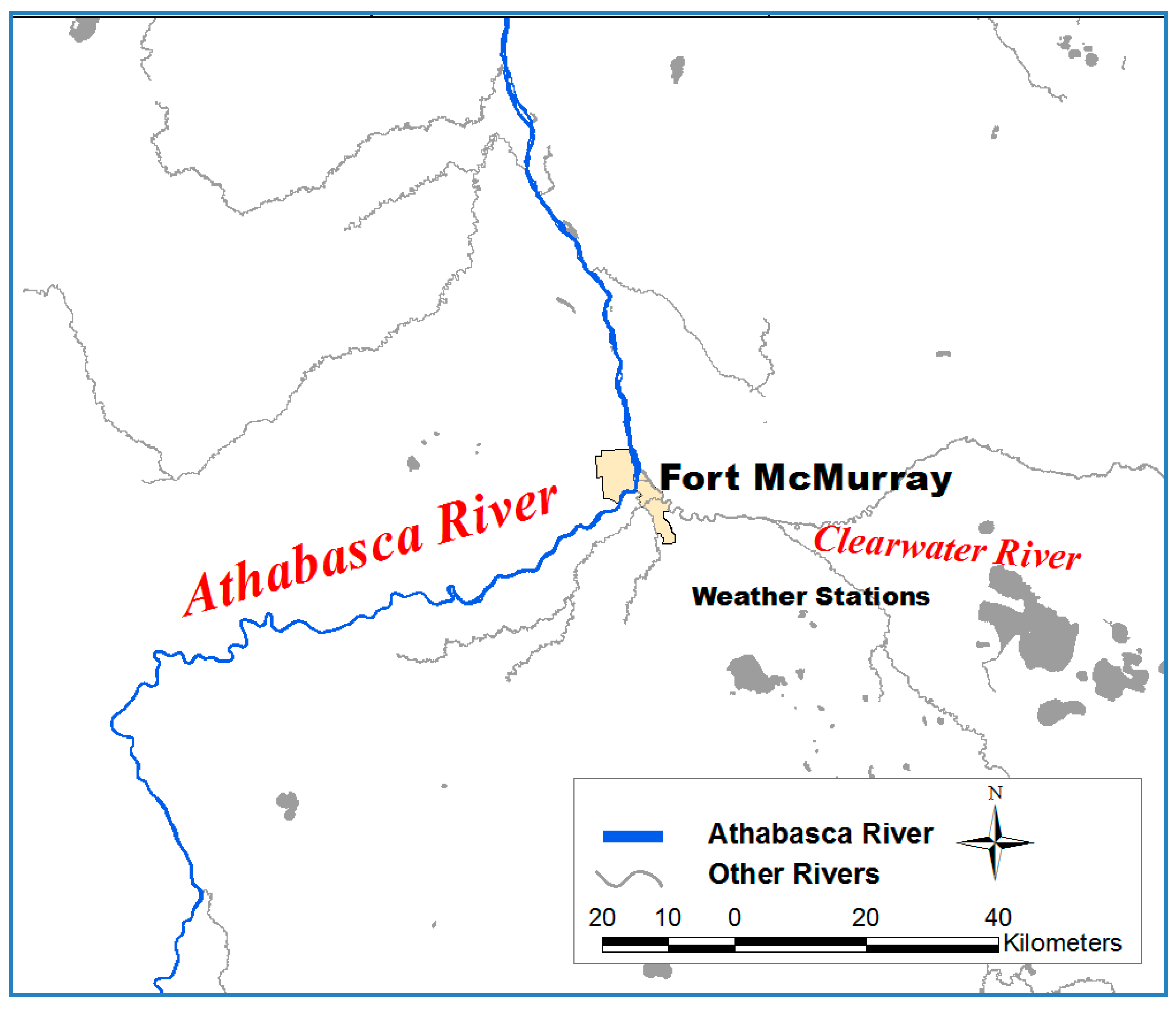
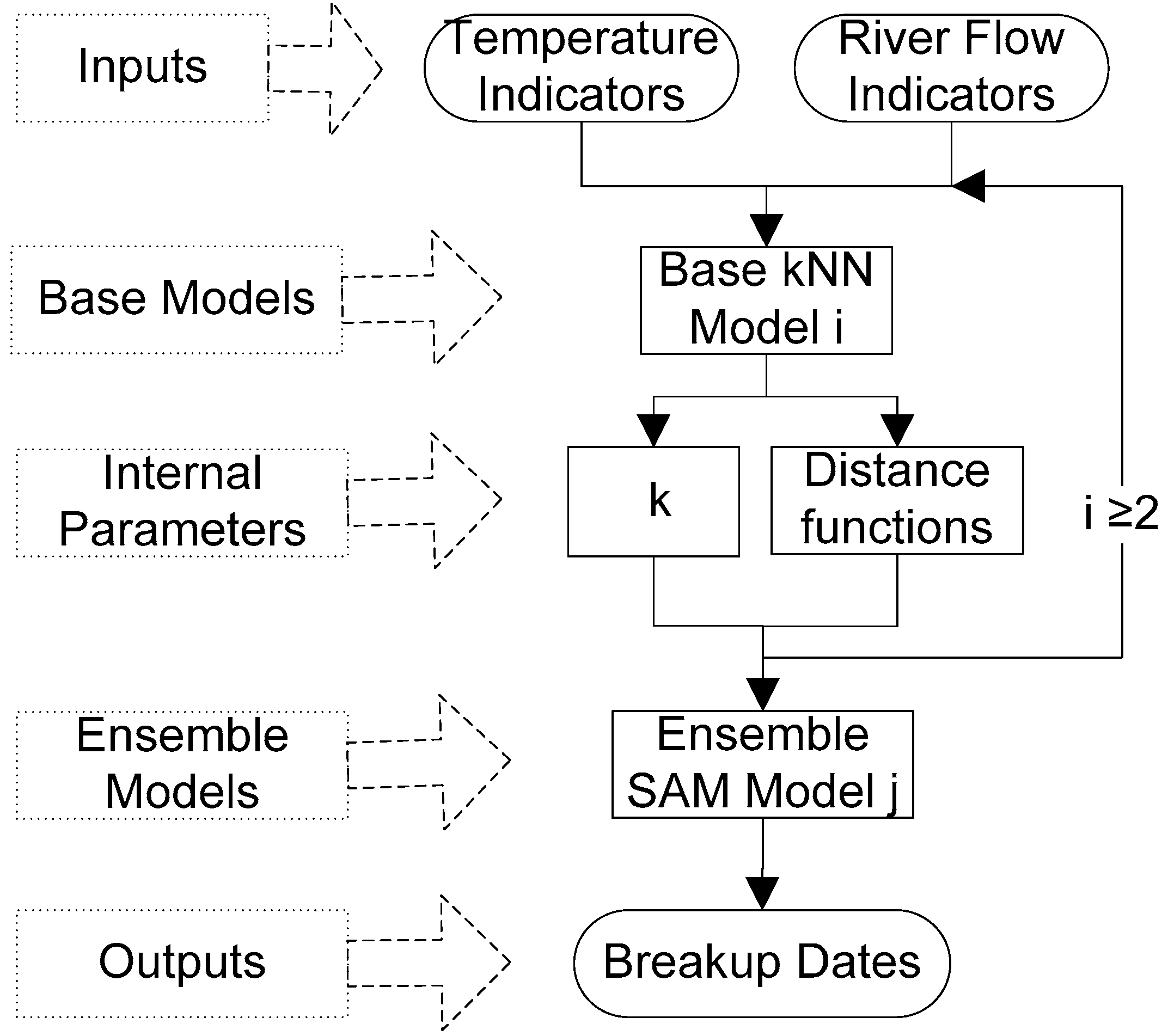
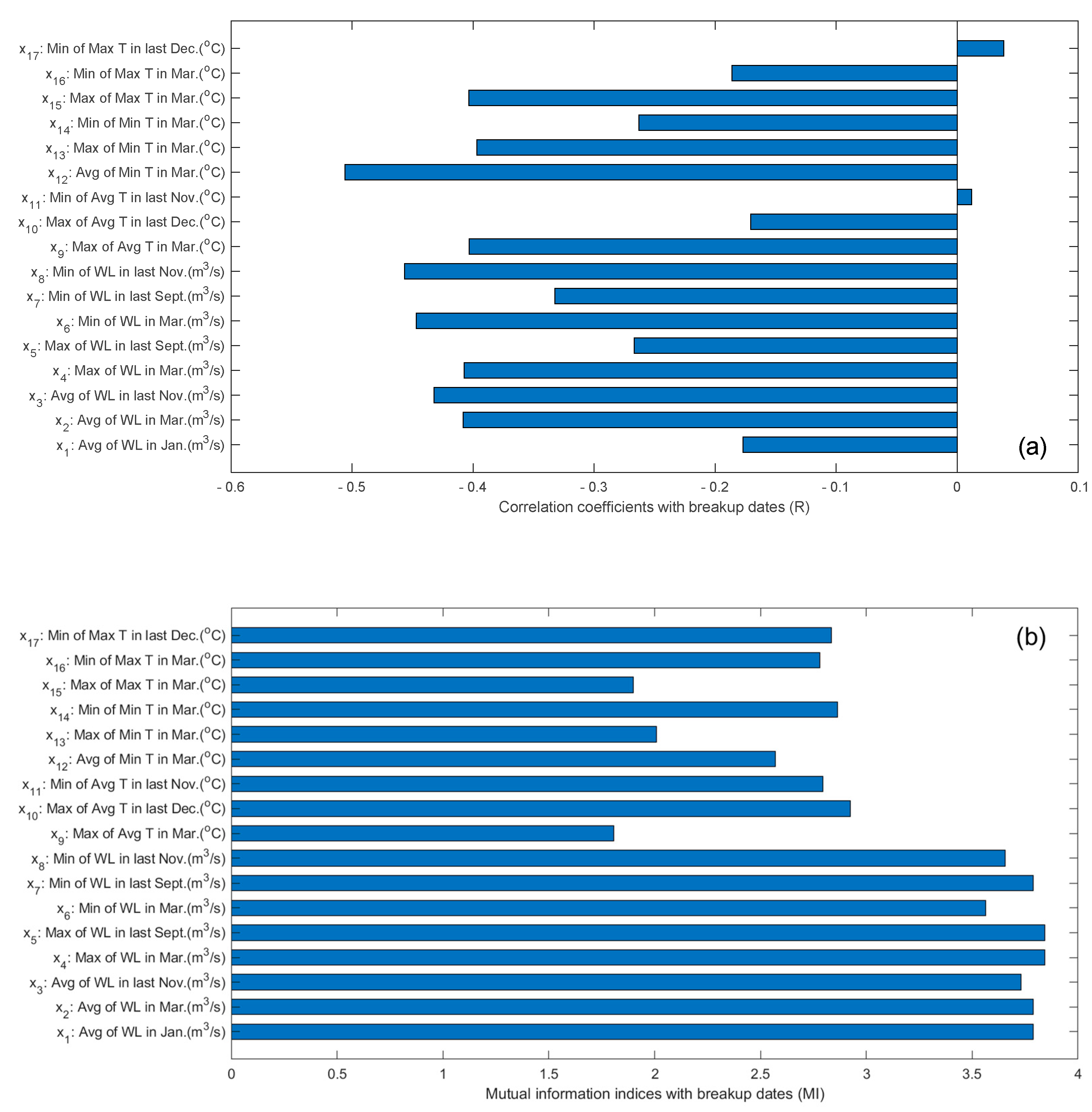
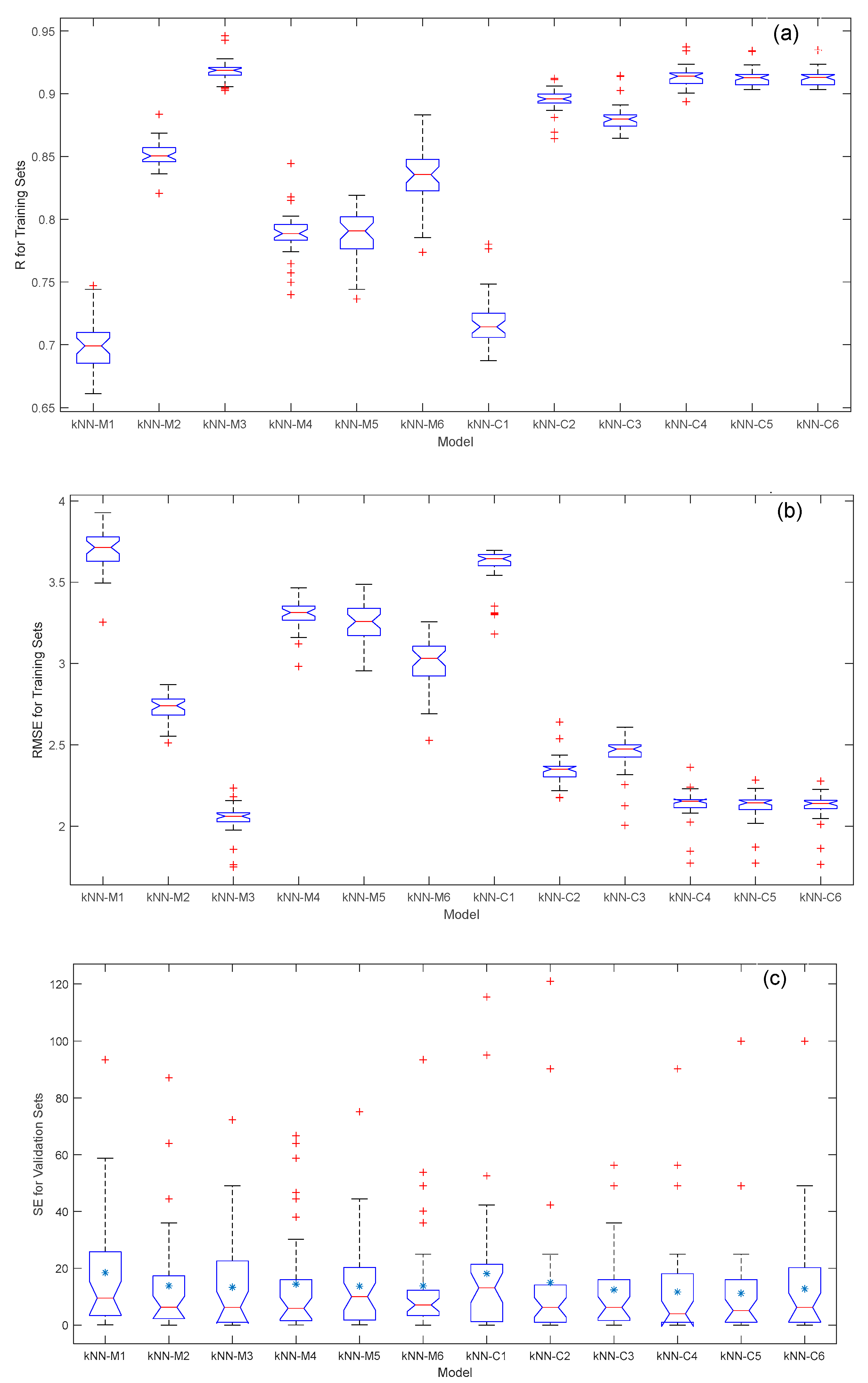
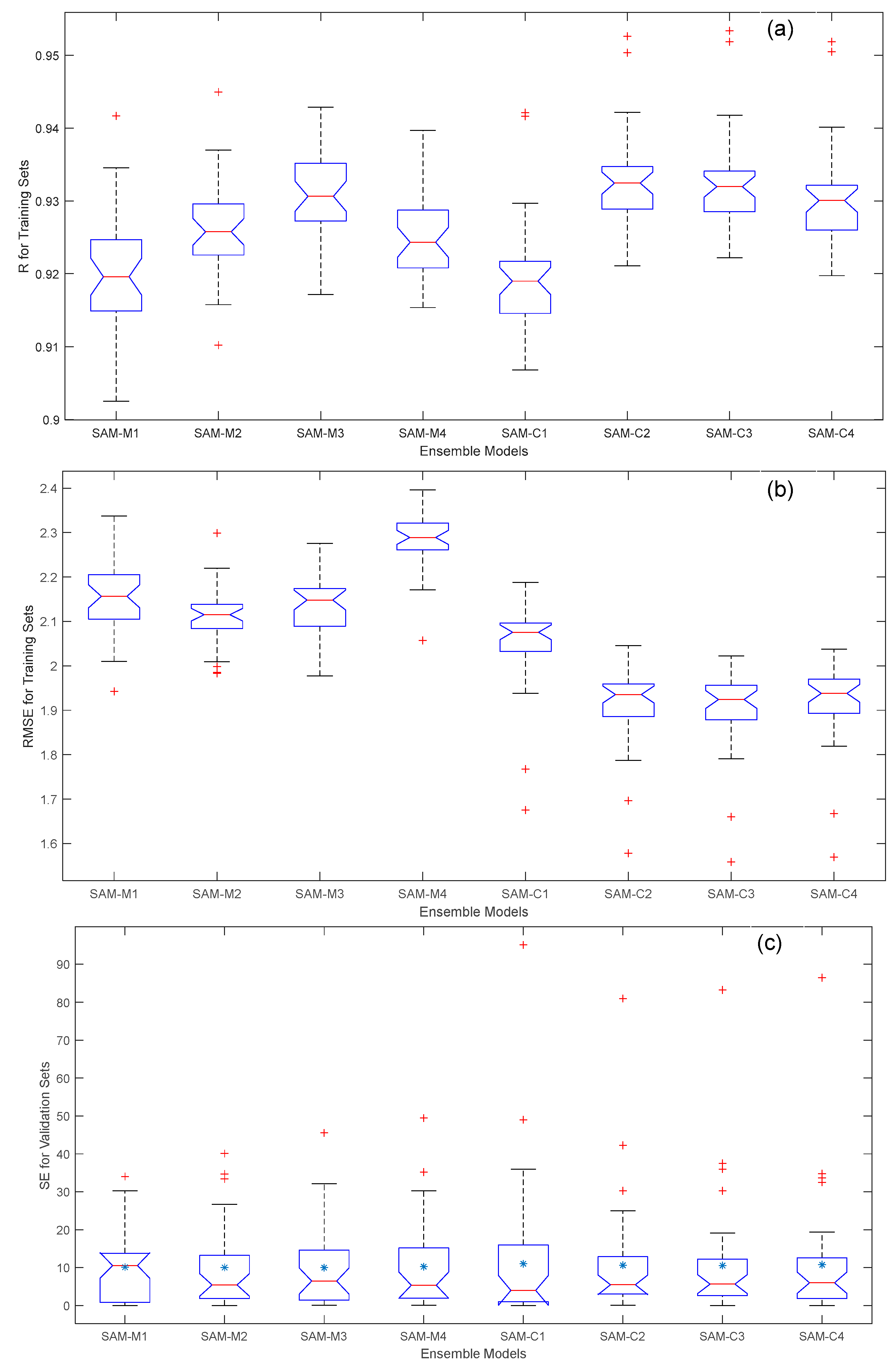
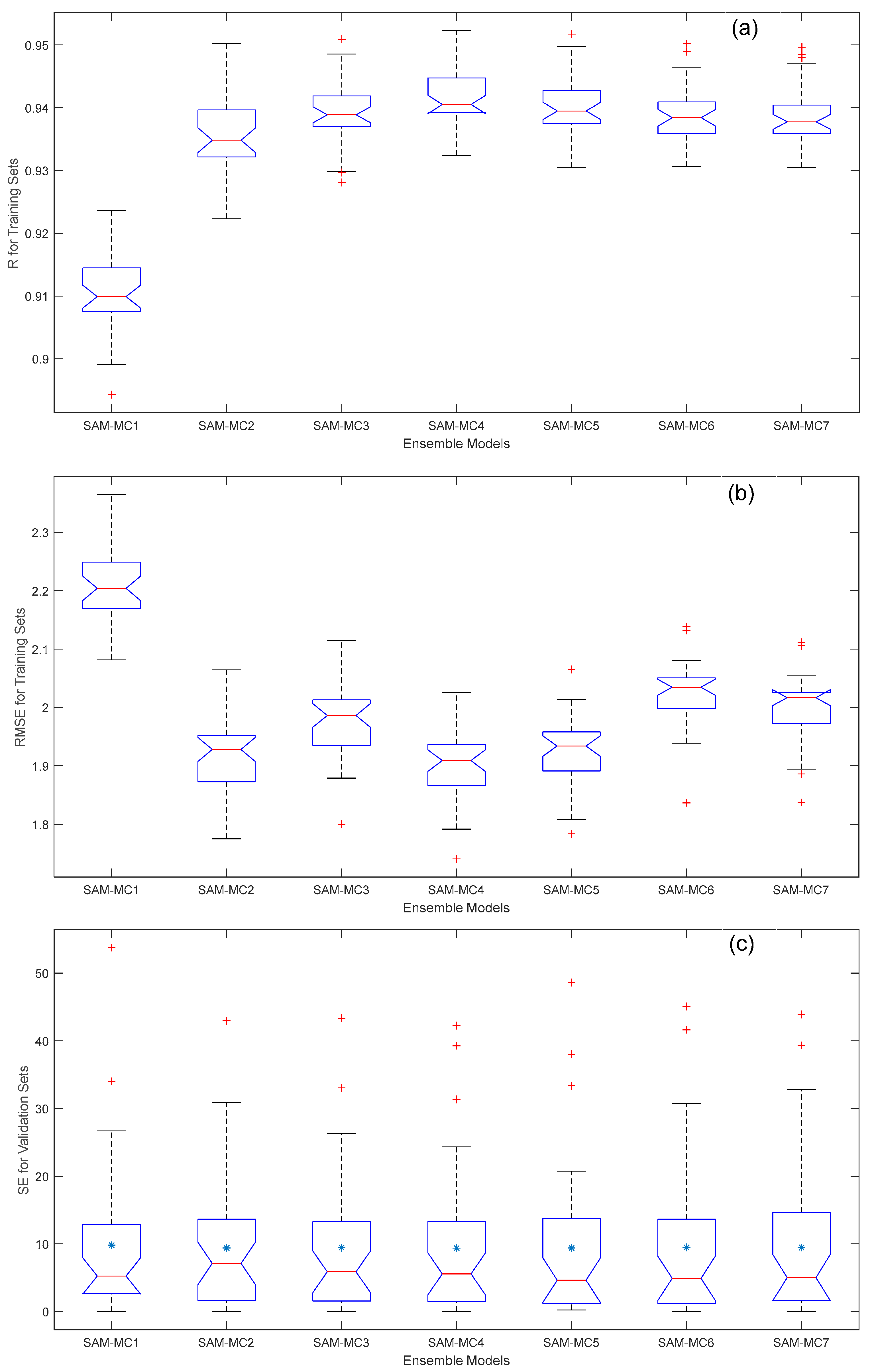
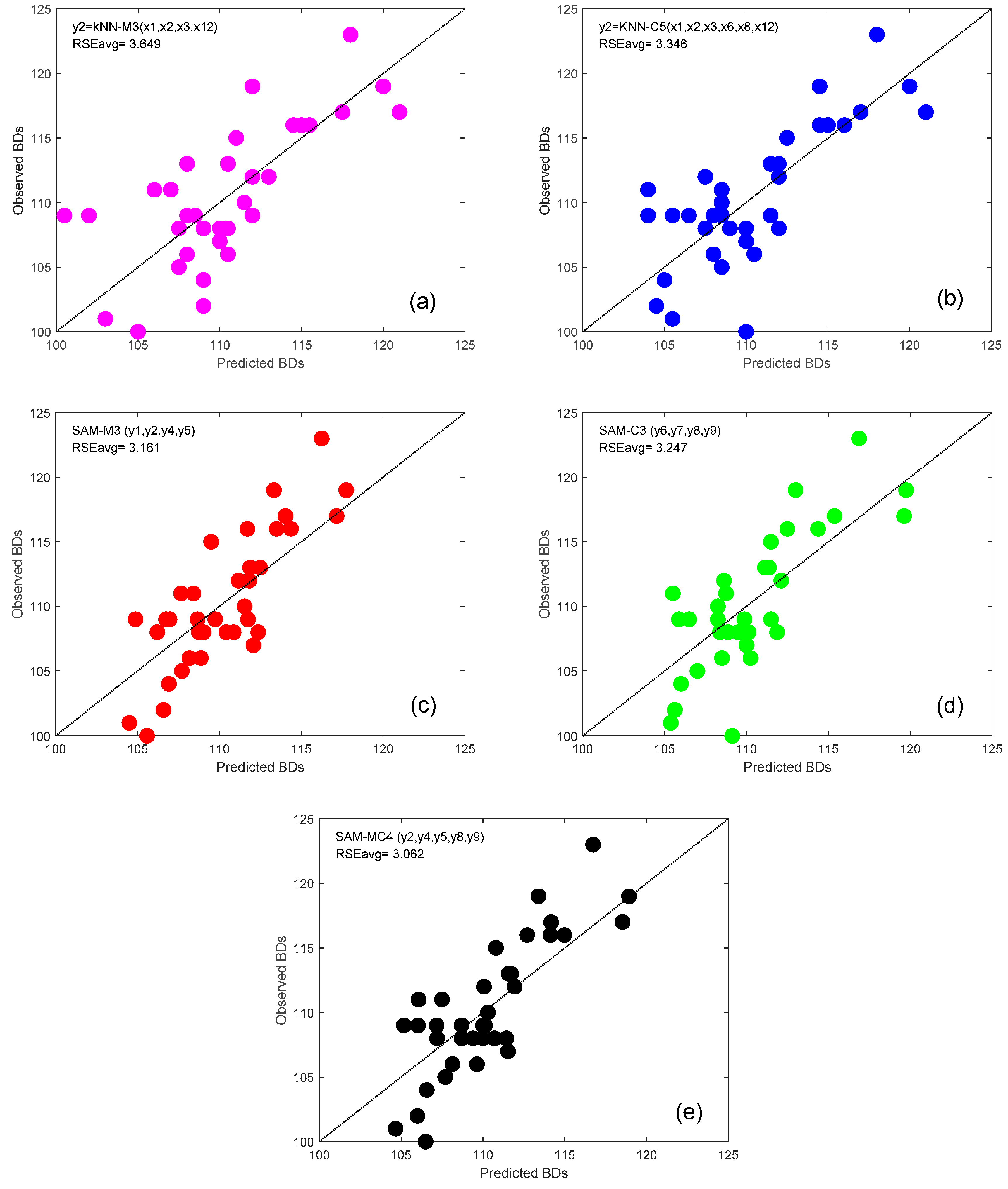

| Model | Inputs | k | Output | Training | Validation | |
|---|---|---|---|---|---|---|
| Ravg | RMSEavg | RSEavg | ||||
| kNN-M1 | x3, x12 | 6 | - | 0.7014 | 3.697 | 4.296 |
| kNN-M2 | x3, x12, x15 | 3 | y1 | 0.8513 | 2.724 | 3.718 |
| kNN-M3 * | x1, x2, x3, x12 | 2 | y2 | 0.9187 | 2.049 | 3.649 |
| kNN-M4 | x1, x2, x6, x10, x15 | 6 | y3 | 0.7884 | 3.299 | 3.800 |
| kNN-M5 | x2, x10, x11, x12, x15, x16 | 3 | y4 | 0.7872 | 3.254 | 3.702 |
| kNN-M6 | x1, x6, x10, x13, x15, x16, x17 | 3 | y5 | 0.8345 | 2.997 | 3.717 |
| Model | Inputs | k | Output | Training | Validation | |
|---|---|---|---|---|---|---|
| Ravg | RMSEavg | RSEavg | ||||
| KNN-C1 | x4, x14 | 4 | - | 0.7185 | 3.595 | 4.259 |
| KNN-C2 | x6, x12, x14 | 2 | y6 | 0.8951 | 2.342 | 3.868 |
| KNN-C3 | x1, x2, x3, x12 | 2 | y7 | 0.8812 | 2.446 | 3.524 |
| KNN-C4 | x1, x3, x6, x8, x12 | 2 | y8 | 0.9134 | 2.134 | 3.416 |
| KNN-C5 * | x1, x2, x3, x6, x8, x12 | 2 | y9 | 0.9129 | 2.125 | 3.346 |
| KNN-C6 | x1, x2, x3, x4, x6, x8, x12 | 2 | y10 | 0.9127 | 2.123 | 3.574 |
| Model | Inputs | Distance Function | Training | Validation | |
|---|---|---|---|---|---|
| Ravg | RMSEavg | RSEavg | |||
| SAM-M1 | y2, y4 | Mahalanobis | 0.9201 | 2.154 | 3.181 |
| SAM-M2 | y1, y2, y4 | Mahalanobis | 0.9262 | 2.112 | 3.170 |
| SAM-M3 * | y1, y2, y4, y5 | Mahalanobis | 0.9308 | 2.136 | 3.161 |
| SAM-M4 | y1, y2, y3, y4, y5 | Mahalanobis | 0.9249 | 2.283 | 3.202 |
| SAM-C1 | y8, y9 | Chebychev | 0.9191 | 2.054 | 3.319 |
| SAM-C2 | y6, y7, y9 | Chebychev | 0.9328 | 1.913 | 3.262 |
| SAM-C3 * | y6, y7, y8, y9 | Chebychev | 0.9326 | 1.903 | 3.247 |
| SAM-C4 | y6, y7, y8, y9, y10 | Chebychev | 0.9306 | 1.918 | 3.282 |
| Model | Inputs | Number of Distance Functions | Training | Validation | ||
|---|---|---|---|---|---|---|
| Mahalanobis | Chebychev | Ravg | RMSEavg | RSEavg | ||
| SAM-MC1 | y4, y9 | 1 | 1 | 0.9105 | 2.205 | 3.131 |
| SAM-MC2 | y2, y4, y9 | 2 | 1 | 0.9357 | 1.918 | 3.065 |
| SAM-MC3 | y2, y4, y5, y9 | 3 | 1 | 0.9392 | 1.977 | 3.075 |
| SAM-MC4 * | y2, y4, y5, y8, y9 | 3 | 2 | 0.9416 | 1.900 | 3.062 |
| SAM-MC5 | y1, y2, y4, y5, y8, y9 | 4 | 2 | 0.9401 | 1.925 | 3.063 |
| SAM-MC6 | y1, y2, y3, y4, y5, y8, y9 | 5 | 2 | 0.9386 | 1.924 | 3.071 |
| SAM-MC7 | y1, y2, y3, y4, y5, y7, y8, y9 | 5 | 3 | 0.9385 | 1.999 | 3.077 |
© 2020 by the authors. Licensee MDPI, Basel, Switzerland. This article is an open access article distributed under the terms and conditions of the Creative Commons Attribution (CC BY) license (http://creativecommons.org/licenses/by/4.0/).
Share and Cite
Sun, W.; Lv, Y.; Li, G.; Chen, Y. Modeling River Ice Breakup Dates by k-Nearest Neighbor Ensemble. Water 2020, 12, 220. https://doi.org/10.3390/w12010220
Sun W, Lv Y, Li G, Chen Y. Modeling River Ice Breakup Dates by k-Nearest Neighbor Ensemble. Water. 2020; 12(1):220. https://doi.org/10.3390/w12010220
Chicago/Turabian StyleSun, Wei, Ying Lv, Gongchen Li, and Yumin Chen. 2020. "Modeling River Ice Breakup Dates by k-Nearest Neighbor Ensemble" Water 12, no. 1: 220. https://doi.org/10.3390/w12010220
APA StyleSun, W., Lv, Y., Li, G., & Chen, Y. (2020). Modeling River Ice Breakup Dates by k-Nearest Neighbor Ensemble. Water, 12(1), 220. https://doi.org/10.3390/w12010220





